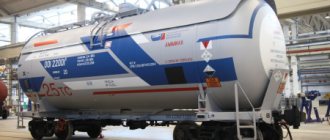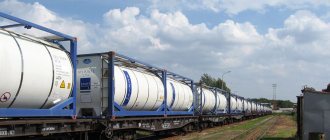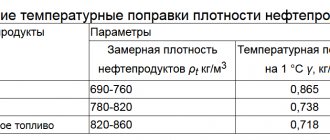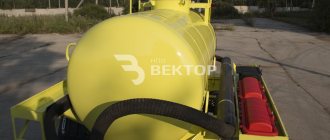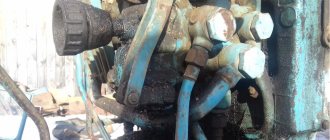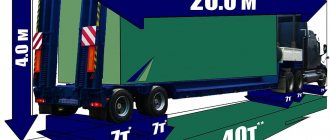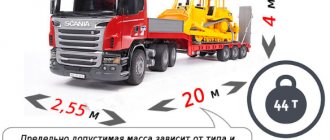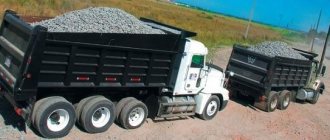Transportation of liquid substances is carried out not only through pipelines. A significant part of petroleum products and technical liquids is transported by rail. For these purposes, rolling stock is used that transports:
- petroleum products and pure oil;
- technical fluids with different chemical aggressiveness;
- liquefied gases.
The design of the tank includes a chassis, frame, drain fittings, safety valves, and cargo condition monitoring devices.
1.4.Calculation of the volume of the settling tank
Previously, the volume of the settling tank is selected from the condition of fuel settling for 8-12 hours. The working volume is assumed to be equal to the total volume of the heavy fuel supply tank. In this case, the settling time will correspond to the set operating time of the supply tank without replenishment. In this case we have
The reserve of fuel in the tank for loss during separation in front of the supply tank is assumed to be 2-2.5% of the working volume of the settling tank:
The sludge volume in the tank is assumed to be 5%, i.e.:
Full volume of settling tank
The height of the tank is selected taking into account the efficiency of fuel settling.
How much does a fuel tanker barrel weigh?
This tank is installed on the Valdai chassis, GAZ 3307, GAZ 3309, GAZ 53. The overall dimensions of the tank are as follows: Length - 3.4 m; Width - 1.2 m; Height - 1.50 m; Weight
476 kg.
Interesting materials:
How to wear Apple headphones correctly? How to wear Samsung BUDS Live headphones correctly? How to raise chickens correctly? How to properly treat a pear from rust? How to properly treat a new wooden door? How to properly handle a gas stove? How to put on and take off gloves correctly? How to properly put headphones in your ear? How to wear AirDots correctly? How to wear AirPods correctly?
Technical characteristics of railway tanks
The tank car model 15-1218 is designed for transportation of gasoline and light petroleum products. The design features a volume of 90 m3 and a lifting capacity of 72.7 tons. By moving the stairs to the console parts, it was possible to increase the volume of the tank. The four-axle chassis evenly distributes the axle load, not exceeding 25 tf. The tank is designed for the transportation of bulk petroleum products with a density of 1000 kg/m3.
Technical specifications:
- weight (package) - 27.3;
- dimensions - 1-T according to GOST 9238-83;
- base - 7.8 m;
- axle length - 12.02 m;
- the internal diameter of the tank is 3.26 m.
The design of the car for liquid cargo does not provide for the presence of a transition platform. To increase transportation safety, the trolley is equipped with a parking brake.
Tank model 15-1218 is designed for long-term operation. The estimated service life is 32 years, and the mileage between routine repairs is 500,000 km (or every 4 years under normal operation).
For the transportation of gasoline, models 15-9892, 15-1210-A (with steam heating of the contents), 15-1219 are also used. Tank car 15-9892 is distinguished by its original design on half-frames, which allows increasing the volume to 192 m3 with a total tare weight of 52 tons. The universal tank 15-1219 with a carrying capacity of 69 tons is capable of transporting 82 types of liquid cargo. It is distinguished by a lightweight platform, which reduces the weight of the container while maintaining useful volume, and the presence of reinforcing ring ribs. Due to the rings, which increase the strength of the tank, the thickness of the metal shells is reduced, which also has a positive effect on the weight of the tank.
1.3. Calculation of the volume of a diesel fuel tank
The volume of the diesel fuel supply tank is recommended to be taken such as to ensure the operation of all consumers at maximum mode during the sea watch, i.e. 4 hours.
Total diesel fuel consumption for 4 hours; kg:
Working volume of the tank, m 3:
The minimum operating level of fuel must ensure the operation of all consumers with a reserve during the time required to replenish the supply tank and additionally for at least 1 hour.
Time to replenish the supply tank; h:
where Q Нdis
– the flow rate of the diesel fuel transfer pump, m 3 /h, is selected taking into account the supply.
In this case, fuel consumption for an additional hour will be, m 3:
The volume of sludge is taken into account in the same way, m 31
Total volume of diesel fuel supply tank, m 3
Draining of railway tanks
Standard drainage devices for railway tanks ensure unloading speed and a high level of safety both during unloading and during transportation and parking. There are special overpasses located along the tracks for unloading gasoline and other petroleum products. The terminal includes devices for supplying and withdrawing petroleum products, located every 4 - 6 meters and connected by a manifold. A separate collector is designed for each type of petroleum product.
Structurally, the overpass is a long gallery with working platforms 3.5 m high. Depending on the load, overpasses are built one-way or two-way. Overpasses for draining gasoline must be equipped with a roof. Bottom drain devices (BODs) are also used to select gasoline. They are connected to tank drain devices equipped with reliable valves and seals. Each tank has one or two drainage devices. To ensure complete drainage, the inner sheet of the boiler is slightly inclined towards the drain hole.
The device consists of two parts: external and internal. The internal node is:
- rack;
- valve;
- barbell;
- sealing ring.
The outer part consists of a cover with a rubber seal, a body welded to the tank, a lock nut and clamping bolts.
Selecting optimal temperature conditions
AND CALCULATION OF ENERGY CONSUMES FOR PREPARATION OF HEAVY FUEL
When refining heavy fuel and supplying it to consumers, it is necessary to ensure an optimal viscosity level. In reserve tanks, it is recommended to heat viscous fuel at the points where it is taken (local heating). In settling, service and slurry tanks, water and steam coils are used, located at the bottom of the tanks. Before the separator, filtration unit and high-pressure pumps, fuel heating can be carried out using track electric or steam heaters. It is necessary to take into account that the use of electric heaters and fuel taken on board the vessel is prohibited in open fuel tanks.
All calculations for this section are performed in accordance with OST 5.5281-75. The purpose of the calculations is to determine the heat consumption and heating surfaces of the coils.
The following temperature conditions are recommended for the preparation of heavy fuel grades DT and F-5:
in the reserve tank 15-30 °C,
in the settling tank 45-50 “C,
in the supply tank 50-55 °C,
in the sludge tank 25-30 °C,
before the separator 60-65 °C
in front of the engines 80-90 °C.
t B as a coolant in tank coils
= 90-95 0 C, and electric heaters are used as path heat exchangers.
What is the length of the tank?
Technical specifications for railway tanks
| tanks model 15-144 | |
| Load capacity, t, no more | 40,8 |
| Maximum calculated static load from the wheel pair on the rails, kN (tf) | 230 (23,5) |
| Length of the gondola car along the clutch axes of automatic couplers, mm, not less | 12020 |
| Boiler volume, m3: | |
1.5.Calculation of the volume of the sludge tank
The capacity of the sludge tank is determined based on the autonomy of the vessel. Fuel losses during separation amount to 2-2.5% of the total reserve of heavy fuel, m:
where is the reserve of heavy fuel for a given autonomy, m 3
The water consumption for washing the drum and hydraulic control of the separator per cycle is 10 liters. Separator operating time, h:
Number of cycles per autonomy:
The total water consumption for washing the drum will be, m 3 ;
The content of mechanical impurities and separated water in heavy fuel is taken = 0.55% of the total fuel supply, m 3
Slurry tank volume:
Calculation of the filling volume of a tank with ball (not hemispherical) plugs by level
To view formulas, your browser must support MathML.
| ads | Last post | |
| For employers and recruitment agencies: Posting vacancies | 26.03.2008 03:07 | |
| Rules and principles of the “Higher Mathematics” forum | 28.10.2009 15:17 | |
| A new section “Tasks and Puzzles” has been launched | 29.08.2019 00:42 | |
I need formulas to calculate the filling volume of a tank with spherical ( not hemispherical)
) stubs according to the level in it https://saveimg.ru/show-image.php? >https://imagepost.ru/?v=ufjumdegquhgoqkjcdpqvqpplucwcc.jpg I have formulas for calculating the volume of filling the contents of a horizontal cylindrical tank, there are three of them, but I couldn’t cope with spherical (not hemispherical) plugs, so I’m interested in formulas for a specifically shaded area https://saveimg.ru/show-image.php? >https://imagepost.ru/?v=ebbffnoihwjjzbzngzdflkweyvabcf.jpg
Edited 1 time(s). Last 09/15/2011 23:09.
The volume of the area you shaded can be calculated as follows: Let $h$ be the height of the tank, $h_1$ the liquid level in the tank, and $R$ the radius of the outer sphere. Then the required volume of the shaded area (as an area cut off from the ball by two perpendicular planes) is equal to
I think if you have any mathematical package, you can easily get a numerical value for your volume. If you want to get the exact formula, then you can try to calculate the indicated integral, which with a series of substitutions is reduced to the integral of a rational fraction, but I’ll tell you in advance, don’t expect anything good, the exact formula turns out to be simply terrifying in its size and content and there’s no more sense in it, than from those given.
Edited 3 times. Last 20.09.2011 00:08.
I am as far from mathematics as the nearest star from the sun, how about this solution?
Let: Radius of the ball plug R Radius of the tank D (D>=R) Liquid level H (H $R – sqrt$ We integrate first vertically (y), then horizontally (x) then along the depth of the drawing All coordinates from the center of the ball. $ int_^ dy int_sqrt^sqrt dx (2*sqrt)$
Edited 3 times. Last 17.09.2011 10:18.
Just some kind of poetry. You don't need to be very good at math. I gave you the formula. You are still interested in the numerical value of the volume, so use, for example, the mathcad package, in it the expressions are specified as they are, but just remember that this formula does not calculate the entire volume of liquid in the tank, but only the volume of liquid located in the protrusion of one ball stubs.
PS Your method is not entirely clear to me.
Edited 2 times. Last 19.09.2011 04:24.
Quote anton25 2) You are still interested in the numerical value of the volume, so use, for example, the mathcad package, in it the expressions are set as is, but just remember that these formulas do not calculate the entire volume of liquid in the tank, but only the volume of liquid located in the protrusion of one ball plug.
PS Your method is not entirely clear to me.
Ideally, I need to depict this formula in Excel, I will be grateful if you depict the double integral in expanded form or share the finished Excel formula
PS I can give you a link to the place where I was taught this formula
Edited 1 time(s). Last 17.09.2011 16:55.
That is, as I understand it, you are interested in the exact formula without integrals and the calculation process itself does not interest you. Well then, take this at your disposal:
Let $h$ be the height of the tank, $h_1$ be the liquid level, $R$ be the radius of the ball plug, $V$ be the volume of the shaded area (the area of the ball cut off by two planes)
I have already said, but just in case, let me remind you that not the entire volume of liquid in the tank is calculated, but only the volume of liquid located in the protrusion of the ball plug (shaded area).
Edited 4 times. Last 19.09.2011 05:20.
Thank you very much for your help
The question is off topic but from the same opera: to calculate the volume of a cylinder I use several formulas for $h_1: $frach_1sqrt$ for $h_1>frac$: $pi(frac)^2-frac(h-h_1)sqrt$ for $h_1 =frac$ : $fracpi(frac)^2$ with $h_1=h$ : $pi(frac)^2$
Is there a single formula (integral) for calculating the volume for any filling of the container?
Calculation of tank volume
The latest version of the program calculates 26 different types of containers! Calibration tables are saved in Excel format and in text form.
Benefits of the RASCET program
The calculation process uses double precision numbers “Double” (16 decimal places) and the method of dissecting a volumetric body with vertical and horizontal planes with a step of 1 mm, which increases the accuracy of calculations tens of times compared to other methods;
The error of the calculations performed is calculated by comparing the volume of the container calculated by the program and the true volume of the container, calculated using simple mathematical formulas. The calculation error is negligibly small compared to the error in level measurement or the accuracy of container manufacturing;
In versions 4.0 and 4.1, the calculated error value is displayed as a percentage with an accuracy of 6 decimal places;
The calculation results are displayed in any step you specify from 1 mm;
The output step of the results does not affect the accuracy of the calculations;
The linear dimensions of containers can be from 1 mm to 100 km;
The program is used at enterprises in the mining industry, oil refining, chemistry, petrochemistry, gas stations, in the food industry, in housing and communal services, in design institutes, in research institutes;
The first version of the program was developed in 2002. The program has been on sale since 2006;
The program is sold in Russia, Ukraine, Kazakhstan, Belarus, Georgia, Armenia, Moldova and other countries;
If you need to calculate a type of container that is not included in the program or change the data output format, write to me. All orders are completed on time.
RASCET program updates
In January 2022, a new version of the Rascet program was released - v 4.1.
The new version has added the display of sketches of all types of containers, with labeled dimensions. For clarity and to avoid errors when entering data.
The new version of the Rascet program is already available for download Rascet v 4.1 (demo version)
Or look at the operating instructions for the Rascet v 4.1 program on the website page.
Video demonstrating the operation of the Rascet v 4.0 program:
If you see this message, it means your browser does not support HTML5 video.
Or watch this video on Yandex. or in another format (23 MB) If the video does not start playing, click Download and after downloading, you can watch it by launching it from the folder where you downloaded it.
An article about calibrating containers using the geometric method.
Do you operate containers or reservoirs and measure the liquid level in them? Measuring the level is necessary to prevent overflow and to know how much liquid is in the container. The level is measured in millimeters, centimeters, meters. And the volume of liquid is in liters and cubic meters. How, knowing the level of liquid in a container, convert it into volume?
If the container is of a simple shape, for example a vertical cylinder, this is not difficult to do. Let's measure the diameter of the cylinder and find out the horizontal cross-sectional area, then multiply the cross-sectional area by the liquid level and get the volume. What if the container has a complex shape? In this case, you cannot do without a calibration table.
There are several ways to obtain a calibration table:
The table can be provided to you by the container manufacturer.
An organization that has a license to calibrate measuring instruments (and a calibrated container is a measuring instrument) and a machine for calibrating containers comes to you and cleans and calibrates the container, gradually pouring water (or other liquid) into it. At the same time, the amount of liquid poured and the level in the container are recorded. Then the container is dried and put into operation. As a rule, this is a rather expensive procedure. And if the container has a large volume (more than 100 m3), the calibration time increases greatly (also the cost). This method is the most accurate and most expensive. It is accurate because what is being spilled is a real container that has dents, internal elements, is not installed strictly horizontally, etc.
We take a method for calibrating (calibrating) a container, for example GOST, and independently calculate the capacity. The accuracy of calculations performed according to the method corresponds to the accuracy of a slide rule; the error can reach several tenths of a percent. For commercial accounting, such accuracy is insufficient.
The table can be calculated using the RASCET program. The cost of the program is tens of times lower than calibration using the pouring method, and the accuracy of the calculation is 2-3 orders of magnitude higher than when calculating using the method. In addition, anyone can use the program (no math background is required), and the calculation results are saved in Excel. The speed of calculations is seconds. Compare this to bulk calibration or manual calculation and you will understand why hundreds of businesses have been using this program for over 12 years.
The program calculates almost all types of containers that we and our clients have: spherical containers, cylindrical containers with flat, elliptical, spherical, torispherical, conical, truncated-conical bottoms, installed vertically, horizontally and with an angle, as well as containers elliptical, rectangular and D-shaped.
New types of containers upon customer request are constantly added to new versions of the program. Also, upon request, you can change the format for saving the results. Clients include large state corporations, small businesses and individuals. Often the program is purchased by organizations involved in the calibration of containers. The method of calibrating a container using a program is called geometric.
Sometimes they write that the program is expensive, but only 1-2 capacities need to be calculated. In this case, I will meet you halfway. The client receives only the calculation results. The cost of the service in this case is only 2000 rubles (for the type of container that is in the program).
The calculation method in the program is based on geometry and is easily verified. You can calculate the total volume of the container using well-known formulas and compare the result with the total volume of the container calculated by the program. In version 4.0, a similar check has been added and you can clearly see the calculation error for each specific container. It ranges from a few millionths to a few ten thousandths of a percent. This accuracy is more than two orders of magnitude higher than the accuracy of existing level measuring instruments. If this accuracy is not enough for you, I can easily increase it by one or two orders of magnitude, reducing the cutting step (and, accordingly, the number of calculations) by 10 times.
Although the calculation algorithms are based on publicly available formulas, they are unique. The program has been consistently developed for more than twelve years, the algorithms have been constantly improved and refined to achieve the required accuracy characteristics.
